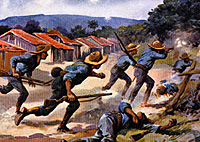 As the Fifth Corps approached the coastline of eastern Cuba, American forces were already ashore, at Port Guantanamo. Huntingdon's Marines (At left and right) had landed here earlier in the month, and had established a base with the support of the US Naval ships blockading Cervera.
As the Fifth Corps approached the coastline of eastern Cuba, American forces were already ashore, at Port Guantanamo. Huntingdon's Marines (At left and right) had landed here earlier in the month, and had established a base with the support of the US Naval ships blockading Cervera.
 Indeed, Cervera had done little to antagonise his besiegers, wisely as they far outgunned
his small squadron. As the troop transports neared closer, Shafter and his staff sifted through all their plans and suggestions, on board Shafter's Headquarters, the Seguranca transport ship. On the 21st, a meeting was arranged by the US staff, to discuss the landings. Held at the village of Aserraderos under Garcia's patronage, both Shafter and Sampson attended with numerous military aids and some foreign observers. It was here that Port Guantanamo was ruled out as a landing point. The weather in the region was changing for the worst, and soon the rains
would put paid to what little roadway existed in the Guantanamo area.
Indeed, Cervera had done little to antagonise his besiegers, wisely as they far outgunned
his small squadron. As the troop transports neared closer, Shafter and his staff sifted through all their plans and suggestions, on board Shafter's Headquarters, the Seguranca transport ship. On the 21st, a meeting was arranged by the US staff, to discuss the landings. Held at the village of Aserraderos under Garcia's patronage, both Shafter and Sampson attended with numerous military aids and some foreign observers. It was here that Port Guantanamo was ruled out as a landing point. The weather in the region was changing for the worst, and soon the rains
would put paid to what little roadway existed in the Guantanamo area.
Eventually, through suggestions prompted by Calixto Garcia, Daiquiri was chosen as the primary site, with Siboney to he utilised at a later date. Garcia himself suggested diversionary bombardments from the US ships, with feints carried out by his Cuban forces in the same areas which he knew would affirm the beliefs of Blanco and his subordinates that the Americans would try for Santiago almost immediately. Sampson and Shafter returned to the fleet assured hy the active involvement of Garcia's insurgents that nothing untoward would happen.
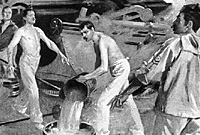 On the morning of the 22nd, with ideal weather and a calm sea state, American ships ranged their heavy guns along any heach that looked like a suitable landing place, both east and west of Santiago. The Spanish garrisons were totally confused.
On the morning of the 22nd, with ideal weather and a calm sea state, American ships ranged their heavy guns along any heach that looked like a suitable landing place, both east and west of Santiago. The Spanish garrisons were totally confused.
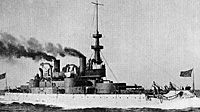 Aguadores, to the east of Santiago, was bombarded by the Gloucester and Eagle, Daiquiri by the New Orleans, Juragua and Siboney by the Bancroft, Helena and Hornet. To the west, the battleship Texas (similar to ship at left), with the Scorpion and Vixen, auxiliary cruisers, moved to Cabanas Bay and shelled Punta Cabrera and the blockhouse at Mazamorra.
Aguadores, to the east of Santiago, was bombarded by the Gloucester and Eagle, Daiquiri by the New Orleans, Juragua and Siboney by the Bancroft, Helena and Hornet. To the west, the battleship Texas (similar to ship at left), with the Scorpion and Vixen, auxiliary cruisers, moved to Cabanas Bay and shelled Punta Cabrera and the blockhouse at Mazamorra.
The Plan
The plan was for General Rabi with an insurgent force of 2,000 men to attack the positions and draw out the Governor of Santiago, General Linares. However, Rabi made a showing with only 200 men, creating no threat to the Punta Cabrera garrison. The US Navy continued with the ruse, even going as far as allowing a number of colliers to steam close to the coast in an attempt at mimicking the troop transports. The Spanish under Colonel Aldea held firm.
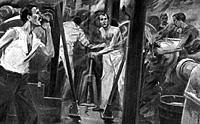 At 0900 hours the New Orleans was joined by the cruisers Detroit, Suwanee and Machias, and the gunboat Wasp, who together continued to shell heavily the area around Daiquiri village and the wooded slopes above. The village was already burning as the Spanish troops had fired it
as they withdrew inland. As the Spanish company departed they left the pier intact, as they had no explosives to complete its demolition, and avoiding the fall of the American bombardment as well as skirmishing with the insurgent guerillas, they headed off towards Santiago. As the troop
transports steamed up to the bombarding ships, at 0930 hours the area was judged to be
secure, the troops loaded into the ship's boats and hauled off to the shore, towed by the steam
launches.
At 0900 hours the New Orleans was joined by the cruisers Detroit, Suwanee and Machias, and the gunboat Wasp, who together continued to shell heavily the area around Daiquiri village and the wooded slopes above. The village was already burning as the Spanish troops had fired it
as they withdrew inland. As the Spanish company departed they left the pier intact, as they had no explosives to complete its demolition, and avoiding the fall of the American bombardment as well as skirmishing with the insurgent guerillas, they headed off towards Santiago. As the troop
transports steamed up to the bombarding ships, at 0930 hours the area was judged to be
secure, the troops loaded into the ship's boats and hauled off to the shore, towed by the steam
launches.
First Man Ashore
The first man ashore from the American Expeditionary Force was one Lieutenant Godfrey of the 22nd Infantry Regiment, closely followed by the 8th Infantry Regiment, both of the 1st Brigade under General Ludlow and then the remainder of General Henry W. Lawton's US 2nd Division. Lawton established an headquarters in the ruin of the village and threw out a screen of patrols and outposts into the hills above. It was here that Lawton and the US troops, and indeed some of the accompanying correspondents, met for the first time, the Cuban insurgent army they had come to assist.
Dressed in rags, barefooted and with an assortment of weapons that would have taxed the resources of even the most adaptable of Quartermasters, the men of the Expeditionary Force were not impressed. The Stars and Stripes were soon flying from the mast over the blockhouse, and the landing continued at a steady pace all afternoon. When most of Lawton's division was safely ashore, part of General John C. Bates' Independent Brigade was disembarked as were a few elements of Wheeler's cavalry division. It would be prudent to note here that this was a cavalry division in name only. In fact in the whole A.E.F. there were very few horses, primarily reserved for the generals and staff, with an inadequate supply of mules for the transport needs of the artillery arm.
Logistics, that is space onboard the transports for the animals and their feed, had meant that their numbers were restricted. When the time came to unload the small but precious cargo ashore, the ships' crews found they had no way of taking the animals off, so unceremoniously, they were all pushed overboard and encouraged to swim for the beach. Shafter all the time was happy to stay on board the Seguranca and observe the day and its proceedings.
By evening, Lawton had 6,000 men ashore, augmented by 1,000 Cuban insurgents under General Castillo. Of the US artillery, only one battery of machine guns had landed. Lawton and his men worked throughout the night to strengthen the pier so that it could take the weight of the American field pieces.
Spanish Response
All through the day, from the opening bombardments to the confirmation received from Daiquiri of the US landing, General Linares had done nothing to hinder the A.E.F. or its new friends the Cuban insurgents. Instead he had ordered all Spanish detachments to fall back upon Santiago. He neither wished to waste his troops defending the numerous blockhouses east of Santiago, nor did he wish to lose any casualties to any renewed naval bombardment. On the evening of the 22nd his outposts and patrols were at Firmeza and Sevilla, north of Juragua, and at the coastal village of Siboney. During the bombardment here the Spanish garrison had lost several casualties including its commander, Major Bollini, to an exploding shell. As the remainder withdrew they gave little thought to the fact that they were leaving the Americans the best possible landing beach in the area.
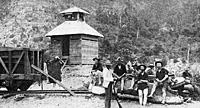 Siboney was in its own bay with a flat, shelving beach that made it easier
to land flat bottomed boats and barges, and even to allow the ill fortuned
horses and mules to wade ashore.
Siboney was in its own bay with a flat, shelving beach that made it easier
to land flat bottomed boats and barges, and even to allow the ill fortuned
horses and mules to wade ashore.
On the 23rd, Lawton moved out from his positions north west of Daiquiri. As most of his force occupied Juragua, his dismounted cavalry elements met up with the first beach parties of General J. Ford Kent's US 1st Division that were now landing at Siboney. This disembarkation was to go on all day and night, illuminated by the searchlights of the escorting warships lying just off the coast. By the evening of the following day, the 24th, all elements of the US 1st Division were ashore, save for two fatalities from the 10th Cavalry.
General Shafter remained still onboard his floating headquarters and continued to issue orders and dispatches from the Seguranca. It has to be said that the poor man was having a rough time of it. Shafter was reputed to be a heavy thick set gentleman, one source stating that at the time he weighed over twenty stone. The humidity was not to his liking and he was in overall poor condition to begin with.
 His most senior officer in place was Major General 'Fighting' Joe Wheeler, a veteran of the Civil War in 1864. Thirty four years had passed since those times when Wheeler served the Confederacy, and he owed his present position to his reputation rather than his military competence. Now, Wheeler had his headquarters established at
Siboney, and between him and Santiago, only a distance of some seven miles, lay some of the worst terrain in eastern Cuba. From a mass of low, wooded hills and narrow winding marshy valleys, what other land remained was covered in dense tropical rain forest. With the increasing
frequency of heavy rain showers, the streams were flooding and bridges were few and far between.
His most senior officer in place was Major General 'Fighting' Joe Wheeler, a veteran of the Civil War in 1864. Thirty four years had passed since those times when Wheeler served the Confederacy, and he owed his present position to his reputation rather than his military competence. Now, Wheeler had his headquarters established at
Siboney, and between him and Santiago, only a distance of some seven miles, lay some of the worst terrain in eastern Cuba. From a mass of low, wooded hills and narrow winding marshy valleys, what other land remained was covered in dense tropical rain forest. With the increasing
frequency of heavy rain showers, the streams were flooding and bridges were few and far between.
The nearest enemy forces to Wheeler and his troops were those under General Rubin, near the village of Sevilla. Here, Rubin had three companies of the Regiment of San Fernando, three companies of the Puerto Rico Regiment, backed up by two mountain guns of light calibre. His orders from Linares were specific to cover the withdrawal of all detachments from the coast range of the Sierra as they retire to Santiago. The Americans, from the reports brought in by the Cuban guerillas knew he was present but had no accurate idea as to his strength. Earlier, near Juragua, Lawton's advance guard had exchanged fire with Major Alcaniz and three companies of the Talavera Regiment, who had then promptly retired to Rubin's position. Wheeler dispatched a scouting party from Siboney that moved on up the Sevilla road. Some Spanish blckhouses were cleared and burnt and a dozen casualties inflicted on the Spanish forces retiring. The A.E.F. had made positive contact.
US Campaign for Santiago Continued
-
Part I: Background
Part II: Provocation
Part IV: Las Guasimas
US Campaign for Santiego Map
Order of Battle
Back to Colonial Conquest Issue 11 Table of Contents
© Copyright 1996 by Partizan Press.
This article appears in MagWeb (Magazine Web) on the Internet World Wide Web.
Other military history articles and gaming articles are available at http://www.magweb.com